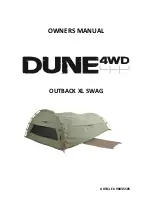
SAFE OPERATION
-
2
Operator safety is a priority. Safe operation, specifically
with respect to overturning hazards, entails understanding
the equipment and environmental conditions at the time of
use. Some prohibited uses which can affect overturning
hazards include traveling and turning with implements
and loads carried too high etc. This manual sets forth
some of the obvious risks, but the list is not, and cannot
be, exhaustive. It is the operator's responsibility to be alert
for any equipment or environmental condition that could
compromise safe operation.
C
Starting
1. Always sit in the operator's seat when starting engine
or operating levers or controls.
2. Before starting the engine, make sure that all levers
are in their neutral positions, that the parking brake is
engaged, and that the hydraulic outlet (if equipped) is
OFF. And make sure the engine hand throttle (if
equipped) is in its idle engine speed position.
3. Do not start engine by shorting across starter
terminals or bypassing the safety start switch. The
vehicle may start in gear and move if normal starting
circuitry is bypassed.
4. Be sure that the operator (and passenger) are properly
positioned and seat belts are appropriately fastened.
5. Do not operate or idle engine in a non-ventilated area.
Carbon monoxide gas is colorless, odorless, and
deadly.
C
Operating
1. Always wear the seat belt when operating the unit.
2. Do not wear headphones while operating.
3. Pull only from the trailer hitch (if equipped). Never hitch
to any other point except trailer hitch; such
arrangements will increase the risk of serious personal
injury or death due to a vehicle upset.
4. Keep all shields and guards in place. Replace any that
are missing or damaged.
5. Avoid sudden starts. To avoid rollovers, slow down
when turning, on uneven ground, and before stopping.
While increasing engine speed with the engine hand
throttle (if equipped), operate the speed control pedal
with great care to avoid sudden starts.
6. The vehicle cannot turn with the differential locked and
attempting to do so could be dangerous.
7. Do not operate near ditches, holes, embankments, or
other ground surface features which may collapse
under the vehicle's weight. The risk of vehicle upset is
even higher when the ground is loose or wet.
8. Watch where you are going at all times. Watch for and
avoid obstacles. Be alert at row ends, near trees, and
other obstructions.
9. When working in groups, always let the others know
what you are going to do before you do it.
10. Never try to get on or off a moving vehicle.
11. Do not stand between vehicle and trailer unless
parking brake is applied.
C
Safety for children
Tragedy can occur if the operator is not alert to the
presence of children. Children generally are attracted to
vehicles and the work they do.
1. Never assume that children will remain where you last
saw them.
2. Keep children out of the work area and under the
watchful eye of another responsible adult.
3. Be alert and shut your vehicle down if children enter
the work area.
4. Never carry children in the cargo bed. There is no safe
place for them to ride. No person under the age of 5
may ride as a passenger in this vehicle. A passenger
under 5 years of age requires special restraints which
are not available with this vehicle.
5. Never allow children to operate the vehicle even under
adult supervision.
6. Never allow children to play on the vehicle or on the
implement.
7. Use extra caution when backing up. Look behind and
down to make sure area is clear before moving.
8. Whenever possible, park your vehicle on a firm, flat
and level surface. If this is not possible, park it across
the slope. Set the parking brake(s), lower the
implements to the ground, remove the key from the
ignition and lock the door (if equipped) and chock the
wheels.
C
Operating on slopes
Slopes are a major factor related to loss-of-control and tip-
over accidents, which can result in severe injury or death.
All slopes require extra caution.
1. Travel straight up or down hill.
2. Reduce load when operating on hilly or over rough
terrain.
3. Keep front wheels straight at crest of hill or going over
bumps.
2. OPERATING THE VEHICLE
(1) Trailer hitch (if equipped)
Summary of Contents for RTV-X1120D
Page 10: ......
Page 16: ...SAFE OPERATION 6 8 DANGER WARNING AND CAUTION LABELS ...
Page 17: ... 7 SAFE OPERATION ...
Page 18: ...SAFE OPERATION 8 ...
Page 19: ... 9 SAFE OPERATION ...
Page 20: ...SAFE OPERATION 10 ...
Page 22: ......













































